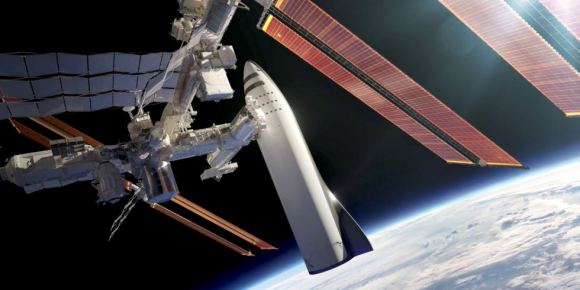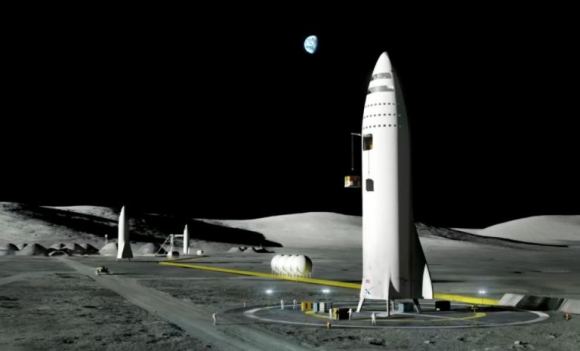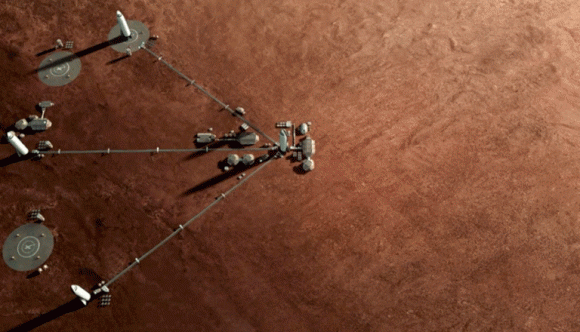For years, Elon Musk and the company he founded to reduce the associated costs of space exploration (SpaceX) have been leading the charge in the development of private spaceflight. Beyond capturing the attention of the world with reusable rocket tests and the development of next-generation space vehicles, Musk has also garnered a lot of attention for his long-term plans.
These plans were the subject of a presentation made on Friday, September 29th, during the International Astronautical Congress (IAC) - which ran from September 25th to September 29th in Adelaide, Australia. During the course of the presentation, Musk detailed his plans to send cargo ships to Mars by 2022, and to conduct regular aerospace trips between major cities here on Earth.
The presentation was aptly titled "Making Life Interplanetary", and featured the latest news about SpaceX's ongoing attempts to build the Interplanetary Transport System (ITS). This massive rocket, which also goes by the code name BFR (Big F***ing Rocket), has been the centerpiece of Musk's long-term goal to send colonists and cargo to Mars in the coming decade.

Artist's impression of the ITS (BFR) conducting a service run to the ISS. Credit: SpaceX
As Musk indicated, the ability to conduct regular trips to Mars and the creation of an aerospace transportation system are inextricably linked. Whereas the colonization of Mars involves creating a fleet of massive rockets, regular aerospace trips would be intended to finance their construction. In short, a downsized version of the ITS could be used to ferry people to and from locations on Earth from Low Earth Orbit (LEO).
As Musk explained to a packed auditorium at a global gathering of space experts in Adelaide:
"The most important thing... is that I think we have figured out how to pay for (BFR). Which is to have a smaller vehicle, it's still pretty big, but one that can... do everything that's needed in the greater Earth orbit activity."
Musk also indicated that his company is developing the components for the ITS (BFR), and that construction of the first ship will start in six to nine months. He expressed confidence that at least two ships could be completed in about five years; at which point, cargo runs to Mars would commence. By 2022, he claimed, these ships would be sent to the Red Planet for the purpose of finding the best source of water.
This water source would be vital in the manufacture of rocket fuel (hydrazine) for future return missions. It could also serve as a source of drinking water for the colony Musk has in mind. Other objectives would include the transportation of key infrastructure to Mars - which means bringing the necessary equipment to provide power, life-support, and mining operations for future missions.

Artists' impression of Moon Base Alpha, SpaceX's envisioned lunar outpost, which would be supplied with the BFR. Credit: SpaceX
This would be followed by four ships making the journey by 2024, which would be responsive for transporting people, equipment and supplies to Mars. Naturally, the price tag for these rockets and the trips they would make would be rather staggering. However, Musk also outlined a range of activities that the ITS would be engaged in that would finance the Mars missions.
These would include launching satellites, servicing the International Space Station, and conducting missions to the lunar surface. Beyond this, Musk also explained how the rockets (or a smaller version of them) could provide aerospace flights between major cities in record time. According to his calculations, he claimed that such flights could ferry customers between Bangkok and Dubai in just 27 minutes, or between Tokyo and Delhi in 30 minutes.
As Musk explained, this form of transportation through LEO would remove a lot of the hassles associated with regular flighst:
"Once you are out of the atmosphere, it would be as smooth as silk, no turbulence, nothing. There's no weather... and you can get to most long-distance places in less than half-an-hour. If we are building this thing to go to the Moon and Mars, then why not go to other places on Earth as well."
For those who recall Musk's 2013 proposal for a "fifth mode of transportation", there are certainly some echoes from his Hyperloop pitch. An means of transit that benefits from reduced air resistance, reduced noise, and can get people to their destinations in very little time. Of course, as with all aerospace ventures, there is the issue of how much an individual ticket would cost. But for those who could afford it, the convenience and novelty alone would be well worth price!

Animation showing the proposed growth of a colony on Mars (click to see animation). Credit: SpaceX
Beyond the questions of cost, there are also the numerous engineering and technical challenges that Musk's latest proposals would entail. Because of the nature of Earth and Mars' respective orbits, trips between Earth and Mars can only take place once every two years. In addition, it would take several months to reach Mars, during which time, the ITS and its crew would be exposed to significant amounts of radiation.
Such concerns are not new, and are also a major part of NASA's proposed crewed missions to Mars - which are scheduled to begin in the 2030s. And taking on big challenges is hardly new to Musk, either. Whether it was the development reusable rockets, electric cars, or the Hyperloop, Musk is known for his ability to find solutions to problems and inspire others to do so as well.
The week-long annual International Astronautical Congress, which concluded on Friday, saw space agencies and private companies from around the world share their plans for the future of space exploration. These included the recent agreement between the Russian space agency (Roscosmo) and NASA to develop the first space station in cislunar orbit that would facilitate missions to Mars and beyond (aka. the Deep Space Gateway).
Other plans included missions to the Moon and Mars in the coming decades. Between NASA, the ESA, Roscosmos, the IRSO, the CNSA, and JAXA, multiple orbiters, rovers and even crewed missions are expected to take to space in the 2020s and 2030s. After decades of being in a serious lull, it seems that we are embarking on a renewed era of space exploration.
In the meantime, check out Musk's video of his proposal to use ITS rockets to conduct aerospace trips around the world:

And be sure to check out the live coverage of the IAC event:
Further Reading: AFP
No comments:
Post a Comment